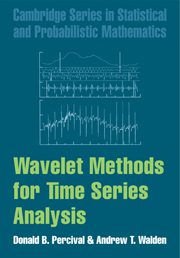Book contents
- Frontmatter
- Contents
- Preface
- Conventions and Notation
- 1 Introduction to Wavelets
- 2 Review of Fourier Theory and Filters
- 3 Orthonormal Transforms of Time Series
- 4 The Discrete Wavelet Transform
- 5 The Maximal Overlap Discrete WaveletTransform
- 6 The Discrete Wavelet Packet Transform
- 7 Random Variables and StochasticProcesses
- 8 The Wavelet Variance
- 9 Analysis and Synthesis of Long MemoryProcesses
- 10 Wavelet-Based Signal Estimation
- 11 Wavelet Analysis of Finite EnergySignals
- Appendix. Answers to Embedded Exercises
- References
- Author Index
- Subject Index
10 - Wavelet-Based Signal Estimation
Published online by Cambridge University Press: 05 December 2013
- Frontmatter
- Contents
- Preface
- Conventions and Notation
- 1 Introduction to Wavelets
- 2 Review of Fourier Theory and Filters
- 3 Orthonormal Transforms of Time Series
- 4 The Discrete Wavelet Transform
- 5 The Maximal Overlap Discrete WaveletTransform
- 6 The Discrete Wavelet Packet Transform
- 7 Random Variables and StochasticProcesses
- 8 The Wavelet Variance
- 9 Analysis and Synthesis of Long MemoryProcesses
- 10 Wavelet-Based Signal Estimation
- 11 Wavelet Analysis of Finite EnergySignals
- Appendix. Answers to Embedded Exercises
- References
- Author Index
- Subject Index
Summary
Introduction
As discussed in Chapter 4, the discrete wavelet transform (DWT) allows us to analyze (decompose) a time series X into DWT coefficients W, from which we can then synthesize (reconstruct) our original series. We have already noted that the synthesis phase can be used, for example, to construct a multiresolution analysis of a time series (see Equation (64) or (104a)) and to simulate long memory processes (see Section 9.2). In this chapter we study another important use for the synthesis phase that provides an answer to the signal estimation (or function estimation, or denoising) problem, in which we want to estimate a signal hidden by noise within an observed time series. The basic idea here is to modify the elements of W to produce, say, W′, from which an estimate of the signal can be synthesized. With the exception of methods briefly discussed in Section 10.8, once certain parameters have been estimated, the elements Wn of W are treated one at a time; i.e., how we modify Wn is not directly influenced by the remaining DWT coefficients. The wavelet-based techniques that we concentrate on here are thus conceptually very simple, yet they are remarkably adaptive to a wide variety of signals.
- Type
- Chapter
- Information
- Wavelet Methods for Time Series Analysis , pp. 393 - 456Publisher: Cambridge University PressPrint publication year: 2000



